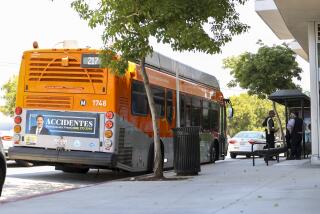Data Belie L.A.’s Auto Image
- Share via
Growing numbers of poor, longer commute times and better public transit may be cutting into L.A.’s love affair with the car.
New census data released Tuesday show that Los Angeles has fewer cars per household than other big cities in California. And the percentage of Los Angeles commuters who rely on mass transit is double the state average, according to Census 2000.
Among the state’s big cities, L.A. ranks sixth in mass transit use, behind such transit-reliant cities as San Francisco, Berkeley and Oakland.
Although the number of commuters is up, there was almost no change in the proportion of people statewide who use mass transit (5%) or carpools (15%). California has spent at least $12 billion on mass transit and adding 800 miles of carpool lanes between 1990 and 2000. That is in addition to local and federal mass transit spending.
A lion’s share of the state transportation money was spent in Southern California, on the 59-mile Metro Rail system in Los Angeles County and the 416-mile commuter rail network that stretches from Ventura County to San Diego County. Together, the two systems cost nearly $8 billion.
Despite new commuting options, about 72% of Californians still drive to work alone; the average commute time has increased about three minutes since 1990, to 28 minutes one way.
In Orange County, about 76% of commuters drive alone, spending 27 minutes on average to get to work, about two minutes more than in 1990.
Over the last decade, Orange County has spent much of its transportation money on expanding a freeway system that is increasingly filled with workers from the Inland Empire, said George T. Urch, spokesman for the Orange County Transportation Authority. He said construction delays and new commuters from Riverside and San Bernardino counties help explain why Orange County commuters are spending so much time on the road.
“We’ve expanded virtually every freeway,” he said.
Urch said he expects local mass transit use to increase in the next few years as his agency considers adding rapid bus lines and new commuter rail extensions. “We are trying hard to come up with alternative transportation growth,” he said, “not just freeways.”
Transportation experts said Californians continue to rely on cars to get to work partly because of relatively low gas prices and a good economy. But transit officials predict that mass transit use will grow as freeways become more crowded and demographic changes bring more low-income transit riders into the work force.
The 2000 census found that L.A. County’s median household income fell since 1990, prompting many to seek more affordable public transportation, said transit planners. Nearly 7% of commuters in the county travel to work by bus or rail. In the city of Los Angeles, more than 10% of commuters use public transportation.
Commute times have increased nearly three minutes in L.A. County, to 30 minutes one way, and county transit officials are upbeat about luring more commuters out of their cars. They note that the county has higher average transit use than the state, and they predict more passengers in coming years.
Jim de la Loza, executive planning officer for the Metropolitan Transportation Authority, said the census data collected in early 2000 do not reflect a dramatic growth in local transit ridership over the last two years. Since March 2000, he said, ridership on the Metro Rail subway line has more than doubled, from 63,750 boardings per day to 130,293.
“In the past couple of years we have made some major improvements,” De la Loza said, and more are planned, including new rail extensions and rapid bus service.
Despite having some of the nation’s worst traffic congestion, Los Angeles drivers do not have the longest commutes. That title goes to the desert community of Lake Los Angeles in the northeast corner of the county, where commute times average 53 minutes one way.
Workers in Palmdale have the longest commute times among cities with a population of 100,000 or greater. Drivers there spend an average of 43 minutes getting to work.
Census data show that such a commute time may be driving Palmdale residents to mass transit. In 1990, the census showed 271 Palmdale commuters used public transit. That number jumped threefold by 2000.
Bill Budlong, executive director of the Antelope Valley Transit Authority, said his agency was launched in 1992 to serve those commuters.
The bus service carries about 500 commuters per day on 14 buses, and Budlong said demand continues to grow.
More to Read
Sign up for Essential California
The most important California stories and recommendations in your inbox every morning.
You may occasionally receive promotional content from the Los Angeles Times.














